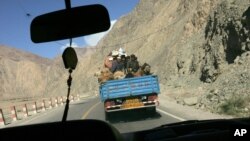China is increasingly asserting its influence economically and militarily throughout Asia. But its impact can also be felt further afield, through foreign aid and investment, particularly in Africa.
Chinese officials in recent months have been promoting the establishment of two new so-called Silk Roads - one a land-based road and another a maritime trade route that authorities hope will further unite China economically with other parts of the world.
Earlier this summer China hosted a Silk Road Economic Belt Media Cooperation forum in Beijing, which state media said was intended to “rejuvenate the Silk Road by encouraging interregional development.”
Trade routes
The original silk road was a series of ancient trade routes that linked the major economies of Asia to trading partners in Europe and the Mediterranean.
"We have seen repetition or an insistence on the concept of a maritime Silk Road and a Silk Road economic belt that may announce a development of a specific strategy or an emphasis on constructing a new axis that may guide regional policy," said Alice Ekman, a Research Fellow for China at the French Institute of International Relations.
She says the strategy is not a new one, but China has raised establishing Silk Road economic belts to a new level of priority.
"So why do I think this topic is relevant, it is because the region itself is presented officially as a priority, even more than [under China’s former leader] Hu Jintao," Ekman said.
China is rebranding the ancient trade routes to boost trade ties and infrastructure throughout the region. As envisioned by Chinese officials the new land-based Silk Road would go through Central Asia to northern Iran and through Iraq, Syria and Turkey, ending in Europe.
Rebranding the infrastructure
The maritime Silk Road would go through the Malacca Strait to India, Kenya and then north around the Horn of Africa, through the Mediterranean before meeting the land-based Silk Road in Venice.
China’s ancient leaders took extensive steps to protect their trade routes and ensure commerce ran smoothly, and observers say the new routes are no different.
Ekman says China is increasingly asserting itself along the trade routes through hard moves, such as territorial disputes in the South China Seas, and soft moves, such as increased aid to countries in Africa.
"So I think what we've seen is a lot of governments gradually saying, the things you've done have been really helpful," she said. "Setting up the agricultural training centers, bringing out the doctors, building the government buildings, etc. but we are now likely to be doing things that have a more direct impact on poverty reduction at a grass roots. And now the question for our Chinese counterparts is not whether to do that, it's how."
Energy security
China is also forming free trade agreements and promoting greater use of its currency in some countries along these trade routes. The increase in ties between China and these countries will not only boost trade, but also will increase China’s energy security.
Some analysts caution that China’s rebranding of these international trade routes does not signal a coherent national strategy.
"There is hardly anywhere, where there isn't an impact, from the smallest islands to the largest developing countries, such as India," said Barry Sautman, an associate professor at the Hong Kong University of Science and Technology. "Whether there is a strategy on the part of China is a very different question. It seems to me there are strategies as opposed to a strategy. In China there are a lot of people proposing strategies, and there is no one strategy adopted by the central government of China."
Sautman says some of these policies are based on contradictory ideas being put forward by officials, business people and academics in China on how best to engage with the rest of the world.









